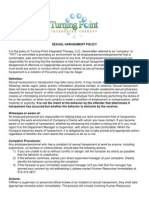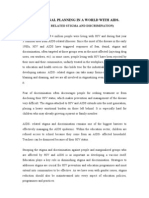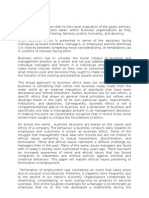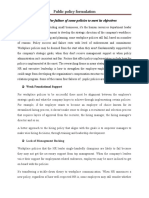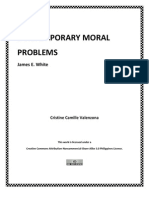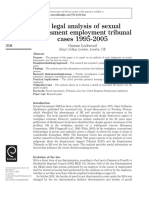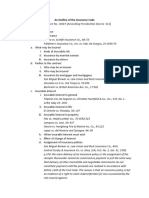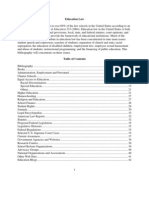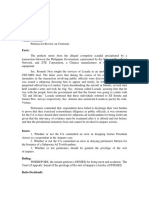Anti - Discrimination and Non - Harassment
Anti - Discrimination and Non - Harassment
Uploaded by
Kishore AustinCopyright:
Available Formats
Anti - Discrimination and Non - Harassment
Anti - Discrimination and Non - Harassment
Uploaded by
Kishore AustinOriginal Description:
Original Title
Copyright
Available Formats
Share this document
Did you find this document useful?
Is this content inappropriate?
Copyright:
Available Formats
Anti - Discrimination and Non - Harassment
Anti - Discrimination and Non - Harassment
Uploaded by
Kishore AustinCopyright:
Available Formats
PEACEFUL COEXISTENCE
The Company respects the religious, geographical and cultural diversity of its employees and
expects that all employees will work in an environment, which promotes and supports peace &
harmony. Provoking and hurting the sentiments of the individuals belief and values should be
avoided.
Anti-Discrimination and Non-Harassment
LKP is committed to ensuring a safe workplace free from any form of discrimination or
harassment. Harassment of any type (i.e. sexual, intimidating or victimization) is totally
unacceptable at LKP, and will not be tolerated. Discrimination and harassment are not only
offensive and unacceptable, but also unlawful.
The Anti-Discrimination and Non-Harassment policy applies to all LKP employees during work
hours and in any other work related context including conferences, work functions, office parties
and business or field trips.
Discrimination
Discrimination occurs when an employee is treated less favorably than others because of that
persons individual characteristics or because that person belongs to a particular group of people.
Discrimination does not have to be calculated or intentional to be unlawful. The intention of the
person discriminating is irrelevant.
Basically, two types of discrimination can occur in the workplace:
Direct Discrimination: This is the result of making distinctions between individuals or
specific groups so as to disadvantage some over others.
Indirect Discrimination: can occur when a policy or practice appears neutral but in fact
results in an individual or group being disadvantaged.
Harassment
Workplace harassment can be based on a persons gender, race, pregnancy, marital status,
disability, age or sexual preference. Harassment usually consists of a pattern of unwelcome
behaviour; however, it can consist of just one act where this is of a serious nature. The most
common form of workplace harassment is sexual harassment. Sexual harassment is behavior of a
sexual nature that is unwelcome or uninvited. It is behaviour that a person finds intimidating,
humiliating or offensive.
Examples of sexual harassment include:
Unwelcome physical conduct such as deliberately brushing up against a person,
Indecent jokes or comments,
Sex based insults, taunts, teasing or obscene gestures,
Display of sexually graphic material including posters, cartoons or the like,
Persistent requests for dates, when it has been made clear that these requests are unwelcome,
Offensive leering, staring or gesturing,
Unwelcome questioning into a persons private life.
Interaction that is consensual, welcome or reciprocated is not sexual harassment.
Responsibility
LKP is committed to maintaining a work environment which is free from discrimination and
harassment and where all employees are treated with dignity, courtesy and respect. LKP regards
discrimination and harassment as serious issues and aims to treat any complaints in a sensitive,
fair and confidential manner.
Failure to implement and support the LKP Anti-Discrimination and Non-Harassment policy may
result in discrimination or harassment. Both discrimination and harassment in employment is
unlawful and can result in legal action and penalties against the company and against individual
employees.
Regional Heads
Regional Heads are responsible for ensuring that the policy is implemented and adhered to on a
day to day basis. As a matter of course, Branch Heads/ Zonal & Functional Heads must:
Ensure that proper standards of conduct are maintained at all times, that harassment is
actively discouraged, and that employees are aware of LKP s policy,
Ensure that their own behavior, and that of their staff, does not create or condone
circumstances which may lead to discrimination or harassment,
Ensure that staff have access to information regarding the channels for advice,
Ensure confidentiality,
Promptly refer any complaints to human resources.
Employees
It is the responsibility of all employees to contribute to a working environment free of
discrimination and harassment and to avoid practices, attitudes and behavior that may be
considered discriminatory.
Should an employee encounter behaviour they consider unacceptable and which they believe
constitutes discrimination or harassment, they should:
Make it clear that the behavior is unacceptable, and
Where the behavior continues, report it to their Reporting Manager/ Zonal Head/ HOD or
Human Resources.
If an employee witnesses an incident of harassment, they should assist the employee by ensuring
he/she is aware of his/her rights and the proper procedure for making a complaint. In situations
where the alleged harassment involves physical contact, the complainant has the right to contact
the appropriate authority.
Human Resources
Human Resources will ensure that:
The Anti-Discrimination and Non-Harassment policy is understood and that Branch
Managers / HODs and staff are educated in responsibilities under the policy,
Information in relation to training about harassment is available,
The policy is monitored to ensure compliance,
Complaints are attended to promptly and with the strictest confidentiality,
Complaints are investigated impartially and treated seriously and sensitively.
PROCEDURE
Responding to Unwelcome Behavior
If an employee is confronted with what they consider could be discrimination or harassment of
any type they should:
Remember that discrimination and harassment are not only contrary to LKP policy, they are
illegalso dont be afraid to tell someone!
Not ignore the discrimination or harassment as this may escalate the behavior,
Make it very clear that the behavior is both offensive and unacceptable,
Make a complaint to their Reporting Manager/ Zonal Head/ HOD or Human Resources who
will take action to rectify the situation,
Be honest and open with the person investigating the complaint about what happened so that
appropriate action can be taken.
An employee who feels they have been subject to discrimination and/or harassment should raise
their complaint in the following way:
In the first instance, speak with the person directly concerned and state that their behaviour is
not welcome and that it is to cease. At this point the complaint may be resolved. If this is the
case, then no further action is required.
If the employee is unable to do this for whatever reason, or if they have approached the
person directly and the behaviour continues, then they should speak to their Reporting
Manager / Zonal Head / HOD or Human Resources.
If the employee feels uncomfortable speaking with their Reporting Manager / Zonal Head /
HOD, they should approach their Human Resources Head. All Reporting Manager / Zonal
Head / HODs must refer complaints to Human Resources for resolution as soon as possible.
As a responsible employer, LKP has constituted a Complaints Committee headed by a woman
and not less than half of its members are women with underlying commitments that:
Complaint resolution should be time bound.
Confidentiality of the complaint procedure is maintained.
Complainants or witnesses should not be victimised or discriminated against while
dealing with complaints.
Please find the Committee Members for the same. Please feel free to contact them in case
you will be having any issues regards the same.
Sr.
No
1
2
3
4
5
Name
Email Id
Hetvi Kotak
Varsha Zaveri
Dhelina Menezes
Anish Unadkat
Dinesh Waghela
hetvi@lkpsec.com
varsha_jhaveri@lkpsec.com
dhelina.menezes@alphacommodities.co.in
anish@lkpsec.com
dinesh_waghela@lkpsec.com
Making a Complaint
The Human Resources Department will handle all complaints; however an employee can make
an initial complaint to:
Their Reporting Manager
Their Head Of Department/ Zonal Head
The Human Resources Department.
If a Reporting Manager / Regional Heads/ Functional Heads or employee receives a complaint, it
must be referred to the Human Resources Department.
Complaint Handling
Human Resources will immediately take the following steps in handling the complaint:
Take prompt action and ensure the strictest confidentiality.
Interview the complainant and clarify the nature of the complaint, by either taking a
statement from the complainant or requesting that the complaint is put in writing.
Notify the complainant of alternatives available in resolving the complaint. This must include
advice that the complainant has the right to lodge the complaint with the appropriate
authority.
Explain to the complainant the conciliation process and possible outcomes.
Proceed with the complaint only if requested to do so by the complainant.
Meet with the alleged harasser.
Fully inform the alleged harasser of the complaint, the name of the complainant and the
complaint procedures.
Give the alleged harasser opportunity to respond to the allegations.
Inform the complainant of the discussion and outcomes of the meeting between human
resources and the alleged harasser. Any proposal for resolution will be discussed.
Keep written records to a minimum to establish the facts and keep all documents secure in
human resources. Information pertaining to the allegation will only be accessible to human
resources personnel. If disciplinary action is required for any party, notations to the effect
will be located in the individuals personnel file.
Provide both the complainant and the alleged harasser with the opportunity to have an
independent person of their choice present at any interviews with human resources.
The process including actions, interviews and documentation is confidential; however it may be
necessary to report a complaint to a member of senior management.
Complaints that are made falsely to cause an individual embarrassment or in retaliation, will be
treated seriously and may result in disciplinary action.
OUTCOMES
Complaint Resolved
The complaint may or may not have been substantiated (e.g. by witnesses or admission),
however the complainant is satisfied by the outcome, and that the behaviour which was the
reason for the complaint, has ceased. Follow up should occur with the complainant in 3 to 4
weeks time to ensure no recurrence. In this case, the complaint will not be recorded on either
partys personnel file.
Complaint Substantiated
If a complaint is substantiated, Human Resources may take one or a combination of the
following actions, depending on the severity of the situation:
Counsel the harasser to ensure they understand how their action(s) could have been
offensive, and the complainants right to work in an harassment free environment,
Gain agreement from the harasser that the behaviour will not occur again,
Gain assurance that there will be no reprisals or victimisation against the complainant, and
that LKP views this as a very serious matter,
Consider disciplinary action,
Inform the harassers Reporting Manager /Zonal Head / HOD of the outcome and request
that they monitor the situation,
Inform the harasser that the complaint and resolution will be filed in human resources and
that they have the right to add their own comments,
Place a notation in the harassers personnel file alerting human resources that there is a
discrete file under the control of the Human Resources Head. No details of the complaint or
its resolution will be included in this notation,
Follow up with the complainant to ensure that the behaviour has ceased and that there are no
reprisals.
Should the claim be substantiated one component of resolution may be disciplinary action.
Examples of disciplinary action that may be considered are:
Warning and counselling on the misconduct,
Transfer to another position with no job advantage,
Closer supervision of conduct,
Suspension of employment,
Termination of employment.
The preferred approach is to resolve complaints through the conciliation process outlined in this
policy. However, in the case of substantiated harassment of a serious nature termination of
employment may be the only option.
Additionally, substantiated harassment of a serious nature may be a police matter and the victim
retains the right to seek police involvement, as does LKP .
Monitoring and Redress
It is important that as a result of an harassment complaint which has been substantiated, the
victim is not disadvantaged in terms of work related opportunities including position, status,
promotion, career development, salary increases, bonuses or learning and development.
All cases will be reviewed on an individual basis and appropriate redress will be considered.
You might also like
- Three Theories of JusticeDocument27 pagesThree Theories of JusticeReza KhajeNo ratings yet
- Form For Legal BeneficiaryDocument1 pageForm For Legal BeneficiaryErlinda Porcadilla100% (2)
- How To Do Conditional Acceptance & Affidavit Inet BANKDocument3 pagesHow To Do Conditional Acceptance & Affidavit Inet BANKlid100% (7)
- Leadership and Management For Service IndustriesDocument17 pagesLeadership and Management For Service IndustriesOanaa ComanNo ratings yet
- POSH Training For HRDocument18 pagesPOSH Training For HRPallavi Nayak100% (1)
- Sexual Harassment PolicyDocument2 pagesSexual Harassment Policyapi-120034842No ratings yet
- McDonald v. National City Bank of New YorkDocument2 pagesMcDonald v. National City Bank of New YorkCourtney TirolNo ratings yet
- Answer To ComplaintDocument8 pagesAnswer To ComplaintBarbara BrownNo ratings yet
- Public AdministrationDocument3 pagesPublic Administration자기여보100% (1)
- Sexual Harassment Prevention Training For SupervisorsDocument34 pagesSexual Harassment Prevention Training For SupervisorskarlyNo ratings yet
- Stigma DiscriminationDocument29 pagesStigma Discriminationemma ajayiNo ratings yet
- Accident PreventionDocument17 pagesAccident PreventionRHChiefNo ratings yet
- Utech, Faculty of Law Discrimination Law: Sexual HarassmentDocument12 pagesUtech, Faculty of Law Discrimination Law: Sexual HarassmentPersephone WestNo ratings yet
- Module 1 - Values & Ethics For Personal & Professional DevelopmentDocument27 pagesModule 1 - Values & Ethics For Personal & Professional DevelopmentAnshul GargNo ratings yet
- Importance of Human ResourceDocument18 pagesImportance of Human ResourceChel GualbertoNo ratings yet
- Case Study SampleDocument5 pagesCase Study SampleNeri NeriNo ratings yet
- Ethical Vs UnethicalDocument6 pagesEthical Vs UnethicalRashed MahmudNo ratings yet
- Code of Ethics in BusinessDocument21 pagesCode of Ethics in BusinessPrecious Dianne PorrasNo ratings yet
- Introduction To HR PDFDocument6 pagesIntroduction To HR PDFMukesh DroliaNo ratings yet
- Ethics in HRM - AssignmentDocument11 pagesEthics in HRM - AssignmentAnkit SharmaNo ratings yet
- Invincibility CaseDocument33 pagesInvincibility CaseParaoprao Tulip60% (5)
- Workplace Violence and AggressionDocument19 pagesWorkplace Violence and AggressionSamKris Guerrero MalasagaNo ratings yet
- Texas House Committee Revises Sexual Harassment PolicyDocument5 pagesTexas House Committee Revises Sexual Harassment PolicyAnonymous Pb39klJNo ratings yet
- Unit 8 Human RelationsDocument36 pagesUnit 8 Human RelationsYogesh KamraNo ratings yet
- Human Resources DepartmentDocument2 pagesHuman Resources DepartmentsegunditoNo ratings yet
- Stakeholder Participation in Policy Formulation-1Document24 pagesStakeholder Participation in Policy Formulation-1Benard Hadad Chale100% (1)
- Public Policy Formulation 2Document13 pagesPublic Policy Formulation 2Abdela Aman MtechNo ratings yet
- Grievance ProcedureDocument21 pagesGrievance ProcedureMuthu KumaranNo ratings yet
- Introduction To HRMDocument27 pagesIntroduction To HRMutshoNo ratings yet
- What Is A Community Leader? Are You One?Document5 pagesWhat Is A Community Leader? Are You One?Rosemarie RamosNo ratings yet
- Workplace Harassment and DiscriminationDocument7 pagesWorkplace Harassment and Discriminationjoshua nyangaresiNo ratings yet
- Common Ethical Issues in The WorkplaceDocument5 pagesCommon Ethical Issues in The WorkplacePXQ DIGITALSNo ratings yet
- Presentation On Personality and AttributesDocument22 pagesPresentation On Personality and Attributes37-Siddharth NairNo ratings yet
- Ethics, Also Called Moral Philosophy, The Discipline Concerned With What Is Morally GoodDocument3 pagesEthics, Also Called Moral Philosophy, The Discipline Concerned With What Is Morally GoodNiyati SoodNo ratings yet
- Salary Inequities Case StudyDocument6 pagesSalary Inequities Case StudyStevenNo ratings yet
- Decenzo RecruitmentDocument19 pagesDecenzo RecruitmentGarima KumarNo ratings yet
- Chapter 7Document28 pagesChapter 7faqeersahibNo ratings yet
- 3M - Harassment PolicyDocument3 pages3M - Harassment PolicyabyisacNo ratings yet
- Distribution of Resources in A SocietyDocument4 pagesDistribution of Resources in A SocietyNasiru DeenNo ratings yet
- PA 208 Report - Public Personnel Admin and EODBDocument23 pagesPA 208 Report - Public Personnel Admin and EODBGlyzel SaplaNo ratings yet
- Discrimination in The Workplace Research LLDocument5 pagesDiscrimination in The Workplace Research LLHardik ShettyNo ratings yet
- Human Behavior in Organization Chapter2 SummaryDocument3 pagesHuman Behavior in Organization Chapter2 SummaryYI Lie Suddenly ZhangNo ratings yet
- Competency and Values Framework For Policing - 4.11.16 PDFDocument20 pagesCompetency and Values Framework For Policing - 4.11.16 PDFRoni ConcepcionNo ratings yet
- 4 Equal Employment OpportunityDocument43 pages4 Equal Employment OpportunityApril Angel Mateo MaribbayNo ratings yet
- Unethical PracticesDocument9 pagesUnethical PracticesZahra IjazNo ratings yet
- Relationship Between Values and EthicsDocument16 pagesRelationship Between Values and Ethicshermandeep5100% (1)
- Contemporary Moral Problems (Chapter 1)Document46 pagesContemporary Moral Problems (Chapter 1)Cristine Camille Valenzona100% (2)
- Concept of Leadership and Leadership StyleDocument33 pagesConcept of Leadership and Leadership StyleRonin Fernandez100% (1)
- Sexual HarassmentDocument11 pagesSexual HarassmentKrip KNo ratings yet
- Republic Act No. 7877Document21 pagesRepublic Act No. 7877Analiza J. Ison100% (1)
- P.Vijayalakshmi Reddy, MSN NimhansDocument51 pagesP.Vijayalakshmi Reddy, MSN NimhansVijaya LakshmiNo ratings yet
- Selection (Human Resource Management)Document12 pagesSelection (Human Resource Management)Ced ZabalaNo ratings yet
- Equality and Diversity Policy October 2011Document7 pagesEquality and Diversity Policy October 2011Dhaval PatelNo ratings yet
- Unit-4: Equal Opportunity and Diversity Management in Global ContextDocument21 pagesUnit-4: Equal Opportunity and Diversity Management in Global ContextLucky GuptaNo ratings yet
- Industrial and Organizational Psychology-SLM2Document12 pagesIndustrial and Organizational Psychology-SLM2CHESSCA ERA100% (2)
- StressDocument26 pagesStressJaskaran Singh NarulaNo ratings yet
- Decision MakingDocument38 pagesDecision MakingShakespeare WilliamNo ratings yet
- Mini-Case Enron's Code of EthicsDocument3 pagesMini-Case Enron's Code of EthicsGarcia, Ralph Gio P.No ratings yet
- A Legal Analysis of Sexual Harassment Employment Tribunal Cases 1995-2005 PDFDocument17 pagesA Legal Analysis of Sexual Harassment Employment Tribunal Cases 1995-2005 PDFHumaidi Ash ShiddieqyNo ratings yet
- A "YES" or A "NO"???Document9 pagesA "YES" or A "NO"???Mary May100% (1)
- Compelling Returns: A Practical Guide to Socially Responsible InvestingFrom EverandCompelling Returns: A Practical Guide to Socially Responsible InvestingNo ratings yet
- Sexual HarassmentDocument12 pagesSexual HarassmentelocindierNo ratings yet
- PD 968 Probation Law 1976Document11 pagesPD 968 Probation Law 1976Leon Odarniem Saniraf EtelpNo ratings yet
- Yes But Is It Vandalism Graffiti Concep PDFDocument10 pagesYes But Is It Vandalism Graffiti Concep PDFSharmaine MararacNo ratings yet
- An Outline of The Insurance CodeDocument6 pagesAn Outline of The Insurance CodeBrylle Deeiah TumarongNo ratings yet
- Sulpicio Lines V CA Digest For TranspoDocument3 pagesSulpicio Lines V CA Digest For TranspoJohn Matthew CallantaNo ratings yet
- Aquino Vs PascuaDocument8 pagesAquino Vs PascuaGabby Schyller GalangNo ratings yet
- Personal Injury Paralegal ResumeDocument7 pagesPersonal Injury Paralegal Resumebcrqhr1n100% (2)
- P Vs ALEGRE 94 SCRA 109Document2 pagesP Vs ALEGRE 94 SCRA 109Chloe RuizNo ratings yet
- Cambridge Credit Corporation LTDDocument2 pagesCambridge Credit Corporation LTDLatifah Md AliNo ratings yet
- Crim Pro - Jo VallesDocument133 pagesCrim Pro - Jo VallesSheena MiñosaNo ratings yet
- Cynthia Setuke Was Murdered Last Year While Working Underground at Aquarius Platinum Mine in Rustenburg, North West.Document2 pagesCynthia Setuke Was Murdered Last Year While Working Underground at Aquarius Platinum Mine in Rustenburg, North West.Gershwin WanneburgNo ratings yet
- Hernandez Vs Rural Bank of LucenaDocument1 pageHernandez Vs Rural Bank of LucenaJeff.AguilarNo ratings yet
- Terms & Conditions Retainer EnglishDocument6 pagesTerms & Conditions Retainer EnglishMichels RolandNo ratings yet
- Education LawDocument42 pagesEducation Lawjoero5167% (3)
- Lalit Civil NoticeDocument6 pagesLalit Civil Noticejags jainNo ratings yet
- Legal Notice of Raman GasesDocument8 pagesLegal Notice of Raman GasesAryan SrivastavaNo ratings yet
- 2015 - Annual Report - FINAL - 4 - 6 - 16 PDFDocument327 pages2015 - Annual Report - FINAL - 4 - 6 - 16 PDFNick ReismanNo ratings yet
- Case No. 28 Lozada vs. Arroyo Gr. No. 184379-80 April 24, 2012Document2 pagesCase No. 28 Lozada vs. Arroyo Gr. No. 184379-80 April 24, 2012NivNo ratings yet
- Chapter 14 - Comparative International Auditing and Corporate GovernanceDocument11 pagesChapter 14 - Comparative International Auditing and Corporate GovernanceLoretta SuryadiNo ratings yet
- The UNCITRAL Arbitration Rules A Commentary 2013Document4,395 pagesThe UNCITRAL Arbitration Rules A Commentary 2013unique festivityNo ratings yet
- ImpedimentsDocument2 pagesImpedimentsPia Monica DimaguilaNo ratings yet
- Kelley V Amazon ComplaintDocument15 pagesKelley V Amazon ComplaintEric GoldmanNo ratings yet
- Demand Notice and Notice of Intention ToDocument8 pagesDemand Notice and Notice of Intention TorachelfranktzNo ratings yet
- National Fair Housing Advocate - September 1999Document8 pagesNational Fair Housing Advocate - September 1999Tony BaizeNo ratings yet
- B0A Tan Chong v. Secretary of Labor, GR 47616, 16 September 1947, enDocument7 pagesB0A Tan Chong v. Secretary of Labor, GR 47616, 16 September 1947, enVince Christian TapiaNo ratings yet
- BustleDocument10 pagesBustleJ RohrlichNo ratings yet
- Unit-12 - Restorative JusticeDocument32 pagesUnit-12 - Restorative JusticeNikhil Vinayakrao BajpaiNo ratings yet





